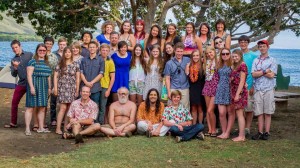This February, twenty-seven Ballard High School students were joined by three teachers and three scientists for a life-changing two-week trip to Maui.
The science-intensive expedition comprised of students exploring the water and mountains of Maui and designing and completing their own field science experiment to receive Ecology credit for the experience.
Prior to departing for Hawaii, students were assigned various “short topics” relating to something the group was going to see or experience over the two weeks. These ranged from the importance of Taro root to Hawaiians to Madame Pele and Hawaiian mythology to the different types of lava flows. Students presented their short topics to the group when time allowed. In the evening, students either had a presentation by one of the scientists or time to work on their own experiments or homework.
Throughout the trip, students were busy learning a curriculum that included marine science, terrestrial science, astronomy, navigation, and Hawaiian history and culture. The group stayed in a camp situated in an ideal location to study marine life. Right on a beach in West Maui, Camp Olowalu sits in a bay with an extensive coral reef system perfect for low-tide walks, snorkeling and kayaking. Whales breech right off the reef, and turtles, octopus and sharks share the reef with countless fish and invertebrates, as well as a few endangered Hawaiian monk seals.
Students slept in A-frame cabins, and shared bathroom facilities. All meals were prepared in the camp’s WWII-era mess hall. Students were responsible for all meals, with each team preparing breakfast and dinner at camp and packing a picnic lunch every day.
Much of the two weeks was spent in the ocean, on the beach or hiking to freshwater streams and waterfalls. Many of the students had completed their scuba certification prior to the trip, and were able to do a number of dives, including a night dive. The group snorkeled or dove nearly every day at such sites as Airport Beach, Ulua, Kapalua, Olowalu, Black Rock, Ahihi bay and Mala Wharf.
About half of the students are members of Ballard High School’s Maritime Academy, and many were from the senior maritime Oceanography course or the Maritime Skills class. The Ballard Maritime Academy steering committee contributed thee partial scholarships to students who could not afford the full price of the trip, and the Pacific Fisherman Shipyard in Ballard contributed two scholarships as well.
At the airport on the first day, the group decided the method they would use to count off to ensure no one was left behind was to shout “Ohana,” the Hawaiian word for family. Throughout the trip, one of the leaders would shout “Ohana” and the students would begin their count-off. The final “Ohana” was on the airplane coming home, when the stewardess came over the loud speaker to ask the Ballard students to do one last “Ohana.”
Students also completed a service learning project at Maui Nui Botanical gardens, learning about the plants endemic to Hawaii, species introduced by the Polynesians and Europeans, as well as their uses and cultivation. Students worked hard to help clear a sugar cane field and then worked even harder turning the handle on the sugar cane press to extract the sweet juice.
Along the infamous Road to Hana, the students also had a chance to hike into Caveman falls and pool, an idyllic fresh-water pool and waterfall dripping with ferns, as well as the O’heo Gulch pools (aka Seven Sacred Pools). They also visited beach caves and lava tubes near the black sand beach at Wai’anapanapa State Park.
Finally, after two weeks of wet bathing suits, minimal bathing, and sand everywhere, the group got dressed up on the last night for the “Drums of the Pacific” Luau at the Hyatt Regency in Kaanapali enjoying the Hawaiian buffet as much as the extravagant show.
After returning to Seattle, the students completed the write-up of their field experiments and presented them to the rest of the Ohana.
All involved agreed it was an incredible adventure and a non-stop learning experience for both students and teachers. Mr. Noam Gundle, the science teacher who organized most of the trip, hopes to make it an annual event, open to all students who have completed Biology.
Photo courtesy of BHS.


